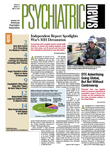Should DSM-V, which is now under development, contain a rubric denoting symptoms that may be related to menstruation? Expert opinions differ today and have shifted dramatically over decades of medical history.
DSM-I (1952) and DSM-II (1968) listed“ psychophysiological conditions” of the various systems but with no descriptions. DSM-III (1980), which offered a new approach to psychiatric nomenclature, proposed the rubric “somatization disorder,” but again with no symptom descriptions. DSM-III placed “late luteal phase dysphoric disorder” in an appendix and suggested further study. DSM-IV (1994) used the term“ premenstrual dysphoric disorder,” keeping it in the appendix, and noted criteria including mood changes, social and occupational impairment, and estimates that the condition affects 3 percent to 5 percent of women. DSM-IV-TR (2000) retained the DSM-IV entry, still in an appendix. The classification of menstruation-related conditions is under study for DSM-V, which is expected to be published in 2012.
“The female malady,” as it was sometimes called, has been noted by physicians for many years. Regina Morantz-Sanchez in her 1985 book about women physicians, Sympathy and Science, wrote that physicians, influenced by the culture of their time, treated the menstrual phenomena as a disease and prescribed rest. Guerin wrote in 1875, “There is no physiological condition so nearly resembling disease as that which produces every month in an adult woman a change so profound that it has been looked upon as an expression of a morbid condition.” Horatio Robinson Storer, M.D., an American (1830-1922), wrote that women subject to periodic infertility were unfit for any responsible effort of the mind and that this periodic infertility may produce temporary insanity. He called it a morbid condition that demands rest.
In 1876, Harvard University awarded its Boylston Prize for an essay titled“ The Question of Rest for Women During Menstruation.” The paper had been submitted anonymously by Mary Putnam-Jacob, M.D. (1842-1906). She based her essay on the findings of a survey that provided replies from 268 women about their family and personal medical histories, education, occupation, and menstrual experiences. The essay reviewed the medical literature, available statistics, and a detailed analysis of the survey findings, including laboratory and sphygmogram examinations.
Putnam-Jacob proposed that nutritional inadequacies and nerve irritation were responsible for menstrual symptoms and that exercise and adequate nutrition were remedies. About 20 percent of the survey respondents stated that menstruation was a period of suffering, but 67 percent said that they were aware of few if any symptoms. She concluded that “nothing in the nature of menstruation [implies] the necessity or even the desirability of rest for women whose nutrition is normal.”
Putnam-Jacob was a remarkable woman. She was born into the Putnam publishing family, and her interest in chemistry led to a degree in pharmacy in 1863, followed by a medical degree in 1864 from the New York Infirmary for Women. Dissatisfied with her medical training, she went to Paris in 1864, spent two years attending medical lectures and clinics, and in 1866 was the first woman admitted to the Ecole de Médecin. She graduated in 1871 with a bronze medal for her thesis.
Returning to New York, she began a medical practice and taught at the New York Infirmary for Women. She was the second woman admitted into the New York Medical Society (Elizabeth Blackwell preceded her) and the first woman admitted to membership in the New York Academy of Medicine. She later chaired the academy's neurology section. She published nine books and 120 articles, some of which dealt with psychiatric topics, such as hysteria and prevention of insanity.
It is ironic to note that Harvard University, which did not admit women to its medical school until 1945, awarded a major prize to a woman physician anonymously in 1876. ▪
